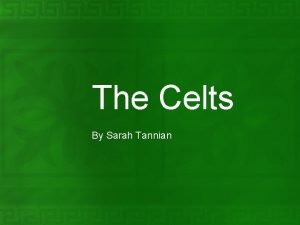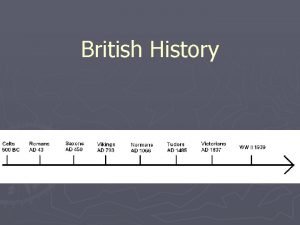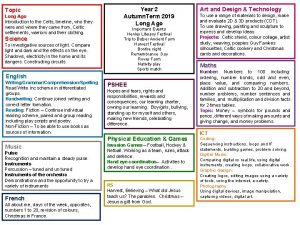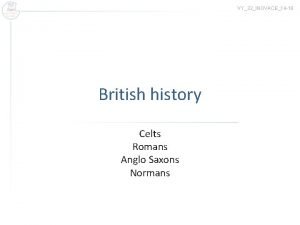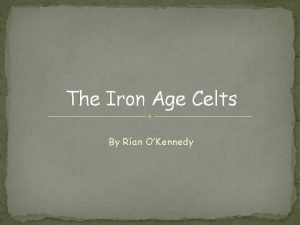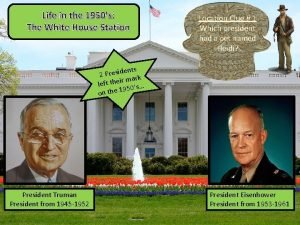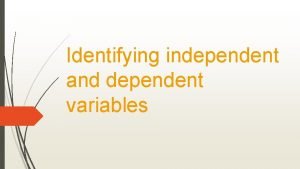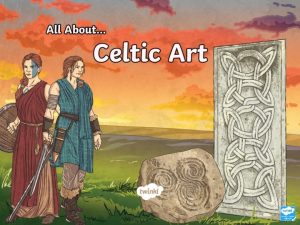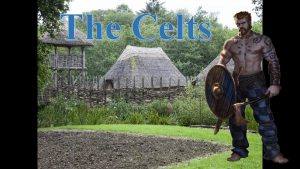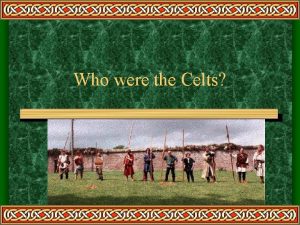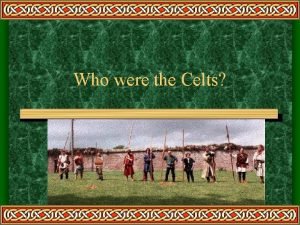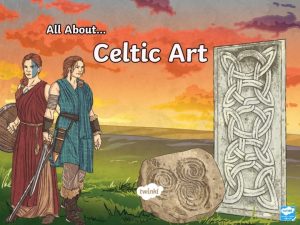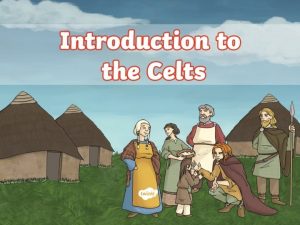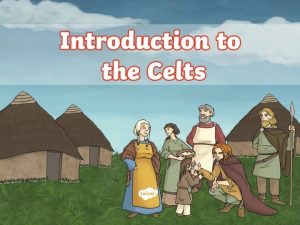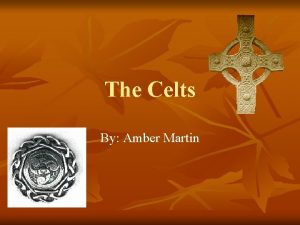Who Were the Celts The Celts were groups












- Slides: 12


Who Were the Celts? The Celts were groups of people who lived in Europe during the Iron Age (800 BC-AD). The Iron Age was the period of time when iron replaced bronze in the making of tools and weapons. It was discovered that iron could be produced from iron ore in a process called smelting. Iron was harder than bronze so made better objects.

Who Were the Celts? There were three main Celtic groups; the Gauls (in Northern mainland Europe), the Britons (in England) and the Gaels (in Ireland). Iron Age Celts lived in Britain and Ireland from 750 BC. Celts lived in tribes, each with their own king or queen. Celtic tribes, in what is now Britain, included the Iceni, the Cornovii and the Ordovices. The Celts ruled Britain until the Romans invaded in AD 43.

Celtic Art Because the Celtic people lived all over Europe, Celtic art is varied. Some of it came in the form of stone carvings, jewellery, pottery, tools and other objects. “The Guard” by Patrimonio Nacional Galegois licensed under CC BY 2. 0 “Celticy widdly-woo”by gajtalbot licensed under CC BY 2. 0 “Glasnevin Cemetery” by William Murphy is licensed under CC BY 2. 0 “Image from page 379 of "The arts in early England" (1903) ” by Internet Archive Book Images is licensed under CC BY 2. 0

How Do We Know About Celtic Art? There are only very limited records from the Celtic period so our knowledge of Celtic art comes from archaeology. This is the study of history through excavating sites and studying artefacts and other remains. Lots of Celtic art was discovered at Newgrange in Ireland. Newgrange is a passage tomb built over 5000 years ago. Archaeologists started excavating the site in the 1970 s. Many different examples of rock art have been discovered. “Newgrange” by Sean Mac. Entee licensed under CC BY 2. 0 “Newgrange” by Regan Buker licensed under CC BY 2. 0

How Do We Know About Celtic Art? The Winchester Hoard is a collection of gold from around 75 BC to 25 BC. It was found in a farmer’s field near Winchester. There were brooches, bracelets and necklaces. The Winchester Hoard was found by a man whose hobby was searching for things with a metal detector. The items are now on display at the British Museum. “The Winchester Hoard”by Portable Antiquities Scheme licensed under CC BY 2. 0

How Do We Know About Celtic Art? In 1950, a farmer was ploughing a field in Snettisham, Norfolk. He uncovered some gold. Over many years, the site was excavated and Celtic jewellery made from gold and other precious metals was found. “The Snettisham Hoard”by Portable Antiquities Scheme licensed under CC BY 2. 0 “Number 46: The Sedgeford torc terminal” by Portable Antiquities Scheme licensed under CC BY 2. 0 “The Snettisham Hoard”by Portable Antiquities Scheme licensed under CC BY 2. 0

Tri-Spirals Tri-spirals, sometimes called triskele, were an important part of Celtic art. They could be found on shields, cups and carved into stone. It is uncertain what the tri-spirals represented. They may have symbolised the cycles of life such as birth, death and rebirth or even the sun, air and water.

Knots Celtic knots are usually created by endless circles or continuous designs. They are a mixture of straight lines and rounded edges. As Christianity started to spread, they were often used on crosses.

Key Patterns Celtic key patterns look a little like Celtic knots but are only made from straight lines. They take their influence from Ancient Greek patterns.

Celtic Art Today Celtic art has inspired art through time. With the spread of Christianity, tri-spirals began to symbolise the Trinity (the Christian belief in God the Father, God the Son and God the Holy Spirit). Celtic knots were used to decorate crosses. Celtic patterns remain popular choices for modern jewellery. “Sterling Silver Celtic Knot Wedding Band Ring” by Lauren Young licensed under CC BY 2. 0 “Glasnevin Cemetery” by William Murphy is licensed under CC BY 2. 0

 Where were the celts from
Where were the celts from How are ethnic groups and religious groups related
How are ethnic groups and religious groups related The celts timeline
The celts timeline The celts timeline
The celts timeline Are celts indo european
Are celts indo european Celts timeline
Celts timeline Celts romans anglo saxons vikings normans
Celts romans anglo saxons vikings normans Where do the celts come from
Where do the celts come from White house 1950s
White house 1950s Students watched a cartoon either alone
Students watched a cartoon either alone Thang điểm glasgow
Thang điểm glasgow Tư thế ngồi viết
Tư thế ngồi viết ưu thế lai là gì
ưu thế lai là gì
